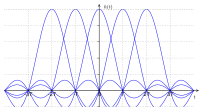
Photo from wikipedia
A training symbol-based equalization algorithm is proposed for polarization de-multiplexing in quadrature duobinary (QDB) modulated polarization division multiplexed faster than-Nyquist (FTN) coherent optical systems. The proposed algorithm is based on… Click to show full abstract
A training symbol-based equalization algorithm is proposed for polarization de-multiplexing in quadrature duobinary (QDB) modulated polarization division multiplexed faster than-Nyquist (FTN) coherent optical systems. The proposed algorithm is based on the least mean square algorithm, and multiple location candidates of a symbol are considered in order to make use of the training symbols with QDB modulation. Results show that an excellent convergence performance is obtained using the proposed algorithm under different polarization alignment scenarios. The optical signal-to-noise ratio required to attain a bit error rate of $2\times 10^{-2}$ is reduced by 1.7 and 1.8 dB using the proposed algorithm, compared with systems using the constant modulus algorithm with differential coding for four-ary quadrature amplitude modulation (4-QAM) and 16-QAM systems with symbol-by-symbol detection, respectively. Furthermore, comparisons with the Tomlinson–Harashima precoding-based FTN systems illustrate that QDB is preferable when 4-QAM is utilized.
Journal Title: IEEE Photonics Technology Letters
Year Published: 2017
Link to full text (if available)
Share on Social Media: Sign Up to like & get
recommendations!